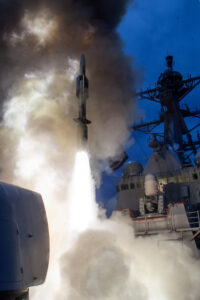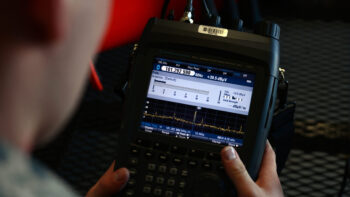
Former US Secretary of Defense Ash Carter passed away at the age of 68. (DoD Photo/Glenn Fawcett)
Former Secretary of Defense Ash Carter passed away at the age of 68 this week. In the following remembrance, senior correspondent Sydney J. Freedberg Jr. notes that Carter’s view of where the world was heading has borne out in the six years since he left the Pentagon.
A physicist turned policy wonk turned Pentagon bureaucrat, Ashton Carter could still take to experimental high technology with the instincts of a showman — and the enthusiasm of a kid.
In May 2016, just over a year into his term as Secretary of Defense, Carter visited a Navy research center and punched in waypoints for a remote-controlled boat on Narragansett Bay. “As a testbed, it had a human being aboard, not as an operator but as a safety officer — just in case,” I wrote for Breaking Defense at the time. “[Carter] emerged from the control room chortling, ‘All right, you’d better tell this guy to hold on for dear life.’
“‘If I did it right, he’ll clear that jetty,’ Carter told his entourage while he watched the speeding boat through binoculars. ‘If I didn’t’ — long pause — ‘there’ll be lessons learned.’”
The boat did clear the jetty.
Later that same trip, Carter got so excited about a 3D-printed prototype sensor on display that he walked away with it, visibly disconcerting the two young scientists who’d been demonstrating it for him. Then, on the plane back to Washington, Carter noticed a no-longer-young reporter repeatedly wrenching off his spectacles to read small print, then popping them back on again to see things at a distance. What you should try, the Secretary told me when he took me aside, is a newfangled technology called progressive lenses, the 21st century alternative to bifocals. He even suggested a specific optometrist in DC.
Such finely focused attention to technical detail is a little atypical for a cabinet official. But it served Ash Carter — and the country — well.
Now, most obituaries for Carter, who died this week at the age of 68, have focused on his headline-grabbing decisions as Secretary of Defense: his opening combat jobs to women; his campaign against the Islamic State; his outreach — ardent, if not always reciprocated — to civilian tech hubs like Silicon Valley. Those are all significant. But equally significant, and relatively unsung, is Carter’s contribution in setting the Pentagon on the strategic course it still follows today.

Defense Secretary Ashton Carter and Singaporean defence minister Ng Eng Hen watch a P-8 scout plane’s sensor crew over the South China Sea in 2016. (Sydney Freedberg photo for Breaking Defense)
A Return To ‘Great Power Competition’
Confirmed as secretary in February 2015 after a lovefest of a Senate hearing — albeit not as Obama’s first choice — Carter inherited a military still fighting intensely with Islamic extremists in Afghanistan, Syria, and Iraq; still rushing to reposition itself in Europe after Russia’s seizure of Crimea and the eastern Donbas the year before; and still struggling to execute the “pivot to the Pacific” that the Obama Administration had proclaimed back in 2012. Within a year, however, Carter’s team — of course, with White House guidance — had crafted the first Pentagon budget request explicitly focused on countering Moscow and China, a focus enshrined in the following year’s National Defense Strategy.
“Two of these challenges reflect a return to great power competition,” Carter declared in 2016. “The first is in Europe, where we’re taking a strong and balanced approach to deter Russian aggression….The second is in the Asia-Pacific, where China is rising.”
Carter’s request highlighted limited but significant seed-corn investments in crucial technologies, like $7 billion for cyber operations, $8 billion for submarines, $71 billion for R&D writ large. Carter kicked off a host of projects to bring in civilian tech-sector best practices, like bug bounties, and to upgrade legacy weapons for new missions. And he reinforced the Strategic Capabilities Office — which he had created in an earlier tour as deputy secretary back in 2012 — to rush new tech into service and repurpose legacy weapons for new missions. “Over the last 10 years,” a Pentagon spokesman emailed reporters Thursday, “37 SCO capabilities have been delivered to the warfighter and nine capabilities are in operational use.”
Admittedly, many of Carter’s specific initiatives petered out, including some highly touted by this website. The Hyper-Velocity Projectile (HVP), meant to fire from conventional artillery so fast that it could intercept incoming missiles, was cancelled last year. The “arsenal plane,” an attempt to turn aging, unstealthy airframes into missile carriers, still putters along in inconclusive experiments. An anti-ship (and anti-Chinese Navy) variant of the Reagan-era Army Tactical Missile System (ATACMS) died off in 2020. And while Carter’s institutional innovations — like the Defense Innovation Unit, the Defense Digital Service, and the Strategic Capabilities Office — have endured, they’ve been niche capabilities rather than revolutions.

Defense Secretary Ashton Carter speaks at the official opening of Defense Innovation Unit (Experimental) Boston in 2016. (Sydney Freedberg photo for Breaking Defense)
But the broader strategic direction has persisted and even gained momentum. For example, when the Army moved away from the upgraded ATACMS, it did so not out of any distaste for anti-ship missiles, but to focus on much longer-ranged weapons, like the new Precision Strike Missile (PrSM) and Mid-Range Capability (MRC), which will also get anti-ship upgrades. The Mid-Range Capability, in fact, takes a Carter-esque approach by repurposing Cold War-vintage naval missiles, the Tomahawk and the SM-6, for launch from land. And it is Carter’s Strategic Capabilities Office that helped upgrade the SM-6, designed as an anti-aircraft and missile defense weapon, to strike surface targets such as ships and ground troops.
This legacy of Carter’s goes well beyond specific missiles. His overarching approach was to counter Russian and, especially, Chinese build-ups by investing in cutting-edge technology — especially tech in which he saw potential for rapid advances that could tilt the balance of power towards the US. Long-range, precision-guided weapons were one big part of that. But so were artificial intelligence, robotics, and unmanned vehicles, as demonstrated by his gleeful robo-boat demonstration back in 2016; since then, there’s even been an SM-6 launch off an unmanned vessel. Carter also pushed to network all these technologies together, whether through tactical networks linking submarines, surface ships, and aircraft, or at strategic headquarters, like the Joint Interagency Combined Space Operations Center (JICSpOC) linking Air Force and National Reconnaissance Office satellites.

The USS John Paul Jones test-fires an SM-6 missile in 2014. (US Navy photo)
From ‘Third Offset’ to ‘All-Domain’
At the time, this complex of concepts and technologies was called, cumbersomely, the Third Offset Strategy. The first offset strategy, in the 1950s and ’60s, used nuclear weapons to “offset” Soviet numerical superiority; the second, in the ‘70s and ’80s, embraced stealth and precision guidance; the third, AI, networks, and long-range strike. Formally launched by Carter’s predecessor, Chuck Hagel, the Third Offset was mainly the brainchild of the man who served both Hagel and Carter as deputy secretary, former Marine artilleryman Bob Work. But Carter, with a PhD in physics, grokked the technology and ran with it in way that Hagel, a Vietnam combat vet turned Senator, had not.
“Ash Carter was a big believer in the critical importance of achieving and maintaining military-technical superiority over all potential adversaries—and it was a goal he worked toward his entire career in the Department of Defense,” Work wrote to Breaking Defense after Carter’s death.
As undersecretary for technology and then deputy secretary from 2009 to 2013, “he helped jump-start the Third Offset Strategy when he established the Strategic Capabilities Office,” Work said. “When he returned as Secretary in 2015, he supported both the Defense Innovation Initiative and the Third Offset Strategy and added materially to them by insisting we could never achieve our aim unless we exploited the vibrant commercial innovation sector.”

Robert Work during his days as DoD deputy secretary (DoD photo)
While Carter stepped down when the Trump Administration took over, Work stayed on for another six months as deputy — and helped ensure many of the Carter-era innovations continued. Ultimately, the two men’s emphasis on coordinating unmanned systems and long-range strikes through inter-service networks gave rise to the ongoing Joint All-Domain Command & Control (JADC2) initiative and the emerging doctrine of Multi-Domain Operations (MDO). (No, the Pentagon’s never gotten any better at naming things).
RELATED: DoD, military services ‘haven’t actually defined’ the JADC2 problem: Navy official
Unlike all too many technophiles, moreover, Carter didn’t see high tech as a solution in itself, but as a tool of strategy. He embraced the Third Offset technologies because he saw them necessary parts of a pivot from hunting Islamic extremists to containing Russia and China, with their large conventional forces, arsenals of long-range missiles, and enthusiastic pursuit of AI.
Carter also used technology as a tool of diplomacy, striking important defense trade accords that brought the US closer to traditionally pacifist Japan and traditionally neutral India. In particular, America’s prized not-quite-alliance with India against China grew, in part, from Carter’s wooing of New Delhi as deputy secretary almost a decade ago.
“Ash Carter moved at the right time and on the right issues to develop better US-Indian mil-to-mil relations,” said Paul Sullivan, an expert on energy and security policy with the Atlantic Council and Johns Hopkins. “He was a diplomat as well as the Secretary of Defense in many ways. He showed how much more a Secretary of Defense could be in the intellectual and diplomatic realms.”
“When it came to technology and strategy, he had few peers,” Work said. “The entire national security community is lessened by his passing.”






















